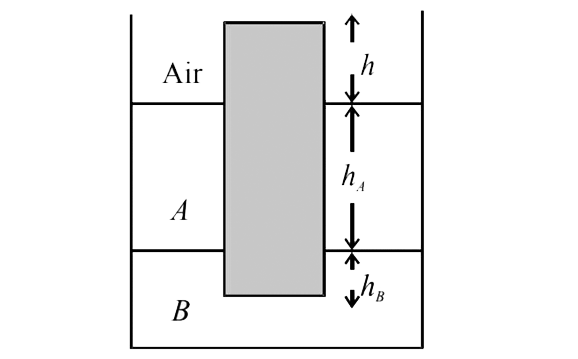Three liquids that will not mix are poured into a cylindrical container. The volumes and densities of the liquids are 1.50 L, 2.6 g/: 0.75 L, 1.0 g/ , and 0.60 L, 0.80 g/. What is the force on the bottom of the container due to these liquids? One liter = 1 L = 1000 (Ignore the contribution due to the atmosphere.)
To solve the problem, we need to calculate the total force exerted on the bottom of the cylindrical container due to the three liquids. The force is equal to the weight of the liquids, which can be calculated using the formula:
F=m⋅g
Where:
- F is the total force,
- m is the total mass of the liquids,
- g is the acceleration due to gravity (approximately 9.8m/s2).
1. Convert Volumes to Cubic Centimeters:
- Liquid 1: 1.50L=1.50×1000cm3=1500cm3
- Liquid 2: 0.75L=0.75×1000cm3=750cm3
- Liquid 3: 0.60L=0.60×1000cm3=600cm3
2. Calculate the Mass of Each Liquid:
- Mass of Liquid 1:
m1=density×volume=2.6g/cm3×1500cm3=3900g
- Mass of Liquid 2:
m2=1.0g/cm3×750cm3=750g
- Mass of Liquid 3:
m3=0.8g/cm3×600cm3=480g
3. Calculate the Total Mass:
mtotal=m1+m2+m3=3900g+750g+480g=5120g
Convert grams to kilograms:
mtotal=5120g×10−3=5.12kg
4. Calculate the Total Force:
F=mtotal⋅g=5.12kg×9.8m/s2=50.27N
Final Answer:
The force on the bottom of the container due to the three liquids is approximately 50.27N.
---
- F is the total force,
- m is the total mass of the liquids,
- g is the acceleration due to gravity (approximately 9.8m/s2).
- Liquid 1: 1.50L=1.50×1000cm3=1500cm3
- Liquid 2: 0.75L=0.75×1000cm3=750cm3
- Liquid 3: 0.60L=0.60×1000cm3=600cm3
- Mass of Liquid 1:
m1=density×volume=2.6g/cm3×1500cm3=3900g
- Mass of Liquid 2:
m2=1.0g/cm3×750cm3=750g
- Mass of Liquid 3:
m3=0.8g/cm3×600cm3=480g
mtotal=m1+m2+m3=3900g+750g+480g=5120g
Convert grams to kilograms:
mtotal=5120g×10−3=5.12kg
F=mtotal⋅g=5.12kg×9.8m/s2=50.27N
The force on the bottom of the container due to the three liquids is approximately 50.27N.
Topper's Solved these Questions
- BOOK - RESNICK AND HALLIDAYCHAPTER - FLUIDSEXERCISE - PRACTICE QUESTIONS (SINGLE CORRECT CHOICE TYPE)48videos
FLUIDS
- BOOK - RESNICK AND HALLIDAYCHAPTER - FLUIDSEXERCISE - PRACTICE QUESTIONS (More than One Correct Choice Type )10videos
FLUIDS
- BOOK - RESNICK AND HALLIDAYCHAPTER - FLUIDSEXERCISE - CHECKPOINT8videos
FLUIDS
- BOOK - RESNICK AND HALLIDAYCHAPTER - ELECTROMAGNETIC WAVES EXERCISE - PRACTICE QUESTIONS (Integer Type)3videos
ELECTROMAGNETIC WAVES
- BOOK - RESNICK AND HALLIDAYCHAPTER - FORCE AND MOTION - I EXERCISE - PRACTICE QUESTIONS (Integer Type)3videos
FORCE AND MOTION - I
Similar Questions
What volume of a liquid (in L) will contain 10 mole ? If molar mass of liquid is 280 and its density is 1.4 g/mL.
View SolutionA uniform solid cylinder of density 0.8g/cm3 floats in equilibrium in a combination of two non-mixing liquids A and B with its axis vertical.
The densities of the liquids A and B are 0.7g/cm3 and 1.2g/cm3, respectively. The height of liquid A is hA=1.2cm. The length of the part of the cylinder immersed in liquid B is hB=0.8cm.

(a) Find the total force exerted by liquid A on the cylinder.
(b) Find h, the length of the part of the cylinder in air.
(c) The cylinder is depressed in such a way that its top surface is just below the upper surface of liquid A and is then released. Find the acceleration of the cylinder immediately after it is released.View Solution
Knowledge Check
- Question 1 - Select One
The density of a liquid at 100∘C is 8.0g/cm3 and at 0∘C is 8.4g/cm3, the coefficient of cubical expansion of the liquid is
A10−4/∘CB5×10−4/∘CC8×10−4/∘CD4×10−4/∘C - Question 2 - Select One
How many molecule are present in 12 L of liquid C Cl4? The density of the liquid is 1.59 g cm−3?
A(a)7.44×1026B(b)0.74×X1026C(c )1.59×1026D(d)15.9×1026 - Question 3 - Select One
A conical vessel having base area 4×103m2 and height 40 cm is filled with a liquid of density 0. 9 grarm/cm3. What is the force acting on the base of the vessel due to the liquid column ?
[Use g=10m/s2]A9.8 NB14.4 NC12.5 ND16 N
Two immiscible of densities 2.5g/cm3 and 0.8g/cm3 are taken in the ratio of their masses as 2:3 respectively find the average density of the liquid conbination.
View SolutionDensity of water is 1.00g/cm3 and density of ethanol is 0.9g/cm3. If these two liquids were mixed to prepare a dilute solution then
View SolutionIn an experiment to determine the densities, four solids A,B,C and D are immersed in a liquid contained in a measuring cylinder one by one. The volume of water displaced by the solids A,B, C and D are 100cm3,100cm3,80cm3 and 80cm3, respectively. When weighed in air, the masses of solids A,B,C and D were found to be 80g,100g,100g and 80g, respectively. The two solids having identical densities are:
View SolutionAt 100∘C and 1 atm, if the density of the liquid water is 1.0gcm−3 and that of water vapour is 0.0006gcm−3 , then the volume occupied by water molecules in 1L steam at this temperature is
View SolutionA gas bubble of 2 cm diameter rises through a liquid 1.75gmcm−3 with a fixed speed of 0.35cms−1.Naglect the density of the gas. The cofficient of viscosity of the liquid is
View Solution

